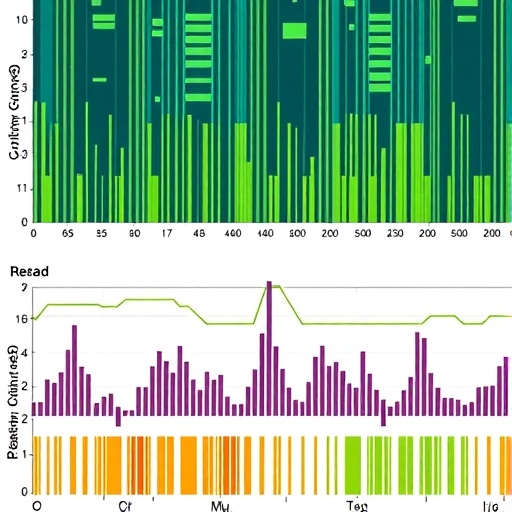In an era where the intricacies of the human genome are being unraveled at an unprecedented pace, a transformative new study has emerged from the cutting-edge junction of genomics and transcriptomics. The recently published research by Liu, Joehanes, Ma, and colleagues, featured in Nature Communications in 2025, heralds a significant leap forward in our understanding of isoform variation—the subtle yet critical ways in which variations in gene transcripts can influence cellular function, disease susceptibility, and therapeutic responses.
This groundbreaking study employs a dual approach, integrating whole genome sequencing (WGS) with comprehensive transcriptome sequencing (RNA-seq), to dissect the genetic architecture underlying isoform diversity. Isoforms, which are alternative versions of messenger RNA (mRNA) transcripts produced from a single gene by mechanisms such as alternative splicing, promoter usage, and polyadenylation site choice, represent a fundamental layer of genetic regulation. Despite their recognized importance, the precise genetic determinants that dictate isoform expression patterns have remained elusive—until now.
The authors embarked on their quest by sequencing both the entire genomes and transcriptomes of a large cohort of individuals, leveraging advancements in next-generation sequencing technologies that provide unprecedented resolution. By juxtaposing the static blueprint of genomic DNA with the dynamic snapshots of mRNA transcripts, the team could directly correlate specific genetic variants with their downstream effects on isoform expression and variation.
One of the most compelling revelations from this integrative analysis is the extent to which non-coding genetic variants—those residing outside of traditional protein-coding regions—play a pivotal role in modulating isoform diversity. These variants influence regulatory elements such as enhancers, silencers, and splice sites, thereby orchestrating complex splicing patterns that ultimately shape cellular phenotypes. The researchers successfully mapped numerous expression quantitative trait loci (eQTLs) specifically affecting isoform abundance, providing a high-resolution atlas of isoform-specific genetic regulation.
The implications of such findings ripple across fields of biomedical research. Differential isoform expression has long been implicated in various diseases, including cancer, neurodegenerative disorders, and autoimmune conditions. By pinpointing the genetic variants that drive isoform shifts, this study offers new mechanistic insights that could transform diagnostics and personalized medicine. It opens avenues to develop isoform-targeted therapies and biomarker strategies that are far more nuanced and effective.
Methodologically, the study stands as a testament to the power of multi-omic integration. The researchers utilized sophisticated computational models capable of handling high-dimensional data and teasing apart the subtle contributions of genetic variants amid a noisy biological background. This robust analytical framework paves the way for future investigations studying the interplay between genomes and transcriptomes in diverse biological contexts.
Moreover, the authors highlight the role of isoform variation in evolutionary adaptation, noting that genetic variants promoting beneficial isoform expression patterns may be subject to positive selection. This evolutionary perspective enriches our understanding of how complex gene regulation evolves and is maintained across populations, adding depth to classical models of genetic variation.
The study also refines our grasp of tissue-specific gene regulation. By sampling transcriptomes from multiple tissue types, researchers uncovered that the genetic control of isoforms is often context-dependent. Certain regulatory variants exert strong effects only in specific tissues, underscoring the necessity of studying isoform variation in physiologically relevant environments to unravel disease mechanisms accurately.
Underlying this research is a growing recognition that transcript variants are not merely transcriptional noise but functional entities with distinct roles. Different isoforms can encode proteins with altered or even antagonistic functions, influence subcellular localization, or modulate interaction networks. Thus, dissecting the genetic architecture of isoform variation transcends academic curiosity—it is vital for understanding cellular complexity and organismal biology.
Furthermore, the integration of whole genome and transcriptome data addresses a fundamental challenge in genetics: bridging genotype and phenotype. Traditional genome-wide association studies (GWAS) often identify variants linked to diseases, yet the mechanisms remain unclear. The present study shows that by focusing on isoform-specific effects, many previously ambiguous variant-function relationships gain clarity, enhancing our ability to interpret genetic data clinically.
This research not only illustrates the current technological capabilities but also forecasts future directions. The comprehensive maps of isoform-associated genetic variants will prove invaluable for advancing single-cell genomics and spatial transcriptomics, where isoform variation could explain phenotypic heterogeneity with even greater precision.
Crucially, the study promotes open science by making its extensive dataset publicly accessible, inviting the broader scientific community to build upon these findings. Collaborative efforts will be essential to fully harness the potential of isoform-centric genetic insights and translate them into tangible healthcare innovations.
In sum, the work by Liu and colleagues represents a paradigm shift in genomics and transcriptomics, emphasizing the necessity of integrative approaches to decode the complex layers of genetic information that define biological function. As sequencing technologies continue to evolve and computational tools become more sophisticated, the detailed genetic landscape of isoform variation will undoubtedly become a cornerstone of precision medicine, illuminating the path from gene to phenotype with unparalleled clarity.
Subject of Research: Integrative analysis of whole genome and transcriptome sequencing to characterize the genetic architecture underlying isoform variation.
Article Title: Integrating whole genome and transcriptome sequencing to characterize the genetic architecture of isoform variation.
Article References:
Liu, C., Joehanes, R., Ma, J. et al. Integrating whole genome and transcriptome sequencing to characterize the genetic architecture of isoform variation.
Nat Commun (2025). https://doi.org/10.1038/s41467-025-64336-8
Image Credits: AI Generated




